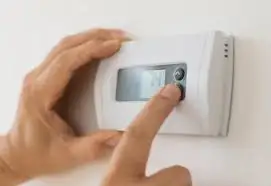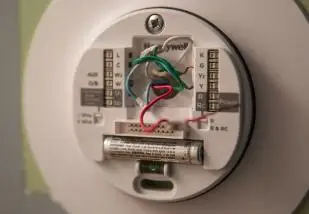How to Connect Honeywell Two Wire Thermostat?
You may be commutation the thermostat that controls your appliances like furnace or air conditioner; otherwise you could also be putting in a thermostat for the primary time. Either way, if there square measure solely 2 wires, your decisions for a replacement thermostat square measure restricted to mechanical or powered models.
If you are looking for a Honeywell two-wire thermostat, you cannot do far better than the Honeywell T87 series. The Honeywell T87 is that the customary spherical thermostat you discover in several older homes, though some newer models have a backlit junction rectifier screen rather than the acquainted graduated scale.

Models with associate degree junction rectifier screen need batteries, however the first mechanical models do not. You could really use any Honeywell thermostat that gets its power from batteries; however you would possibly be paying for practicality that you just will not use. The additional expense is not excessive, though.
Whereas they're designed to regulate heating, cooling and warmth pumps all at identical time, one in all these will undoubtedly operate as a two-wire Honeywell thermostat. Below is the guide to connect Honeywell Two Wire Thermostat.
Purpose of a Two-Wire Thermostat to Connect Honeywell Two Wire Thermostat.

- When you see two wires sticking out of the wall at the location of Honeywell thermostat, it indicates that the thermostat has only one function, which is helpful to switch single appliance on and off and that appliance is furnace.
- In some cases, it could be room heater or an air conditioner anything.
- The circuit formed by the two wires passes through the thermostat and has the same effect on the appliance just as wall switches have on lights.
- Inside the thermostat, when the temperature sensor opens the switch and the appliance shuts down as soon as the electricity stops flowing.
- There are no compressors, reversing valves or second-stage heating functions about which to worry.
Honeywell Thermostat Connection Is Generic
- You will get to see the connection terminals, and the number of terminals depending on the functions of the model, once you remove the back plate of a Honeywell thermostat.
- Be there two, three, four or more, all of them bear generic labeling which is the same on every Honeywell thermostat.
- The two terminals you will always find on the thermostat are the R and W terminals. In which R indicates red and it’s the hot wire coming from the 24 volt transformer which helps in powering the appliance switch. And W stands for white, which is the return wire to the transformer.
- Once both the wires are connected, the circuit is then complete and the Honeywell thermostat is prepared to do the work.
- Remember that the two walls which are coming out of the wall should be red and white and if not, then check the control panel on the appliance to know which wire is which.
- The control panel has the same terminal designations as the Honeywell thermostat.
- Make sure you note the colors of the wires on the R and W terminals and connect them with R and W terminals of the thermostat.
- In case you are controlling an appliance like furnace that too without terminal designations, consider the furnace wiring diagram in order to identify the terminals.

Safety Consideration You Require to Connect Honeywell Two Wire Thermostat.
- A 24 volt wire isn’t too dangerous yet keeping safe is a matter of your choice and its safer to get no shock.
- Turn your breaker off while controlling the furnace or an air conditioner before wiring the Honeywell thermostat.
- Remember that the thermostat won’t work if the wires touch and make a short circuit.
- Check the wire connections primarily if your furnace or air conditioner runs all the time.
- Make sure you have cut off the excess wire that might touch the other terminals while you connect wires to the terminal screws.
We hope the above article helped you Connect a Honeywell Two Wire Thermostat and enjoy the service forever.
 Published by: Blaze
Published by: Blaze Brand: Honeywell Thermostat
Brand: Honeywell Thermostat Last Update: 4 months ago
Last Update: 4 months ago
 Related Blogs
Related Blogs
Why is Honeywell Thermostat WiFi Not Working?
How to Unlock the Honeywell T4 Pro Thermostat?
How to Unlock the Honeywell T6 Pro Thermostat?
How to Wire a Honeywell Thermostat?
How to Reset a Honeywell Programmable Thermostat?
How to Connect Honeywell Two Wire Thermostat?
Why is My Thermostat in Recovery Mode?

Trending Searches
-
Fix Shark Robot Vacuum Error 9 Easily (How) 29 Nov, 24
-
How to Fix Hikvision Error Code 153? - 2025 27 Aug, 24
-
How To Setup WiFi On Samsung Refrigerators? 16 Oct, 24
-
How to Reset Honeywell Thermostat WiFi? 07 Mar, 24
-
Google Nest Mini vs. Amazon Echo Dot 2025 25 Jul, 24
-
How to Set up Arlo Camera? 16 Feb, 24
-
How to Watch StreamEast on FireStick? 05 Nov, 24

Recent Post
-
How to Install Kodi on Amazon Fire Stick? 18 Dec, 24
-
How to Connect Govee Lights to Alexa? 17 Dec, 24
-
How to Connect Kasa Camera to WiFi? 17 Dec, 24
-
How to Fix Eero Blinking White Problem? 16 Dec, 24
-
How to Reset Eero? 16 Dec, 24
-
Why is My ADT Camera Not Working? 15 Dec, 24
-
Merkury Camera Wont Reset? Fix it 14 Dec, 24
-
How to Connect Blink Camera to Wifi? 14 Dec, 24
Top Searches in honeywell thermostat